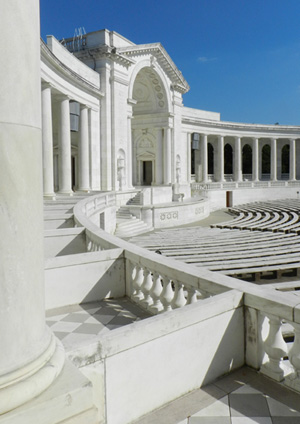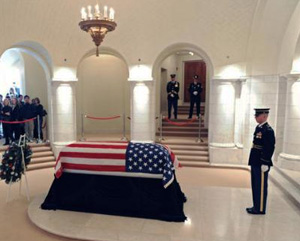
The Memorial Amphitheater at Arlington National Cemetery.
The Memorial Amphitheater at Arlington National Cemetery in Arlington, VA, was dedicated
on May 15, 1920. While many ceremonies are conducted throughout the country, many
consider the services at Arlington's Memorial Amphitheater to be the nation's official
ceremonies to honor all American service members who serve to keep the United States
free.
About 5,000 visitors attend each of the three major annual memorial services in
the Amphitheater. They take place Easter, Memorial Day and Veterans Day and are
sponsored by the U.S. Army Military District of Washington. The Easter Sunrise Service
begins at 6 a.m. Memorial Day and Veterans Day services always begin at 11 a.m.
Many military organizations also conduct annual memorial services in the amphitheater.
The Memorial Amphitheater was the dream of Judge Ivory G. Kimball, who wished to
have a place to assemble and honor the American defenders.
Because of Kimball's campaign, Congress authorized its construction March 4, 1913.
Judge Kimball participated in the ground-breaking ceremony March 1, 1915, but did
not live to see his dream completed. Ivory Kimball died May 15, 1916, and was buried
in Section 3 of the cemetery, near the Memorial Amphitheater he campaigned to build.
President Woodrow Wilson placed its cornerstone Oct. 15, 1915.
One copy of the following items is sealed inside the box placed in the cornerstone
that day:
- The Bible
- The Declaration of Independence
- The U.S. Constitution
- U.S. Flag (1915)
- Designs and plans for the amphitheater
- L'Enfant's map design of the city of Washington, D.C.
- Autograph of the amphitheater commission
- One of each U.S. coin in use in 1915
- One of each U.S. postage stamp in use in 1915
- 1914 map of Washington, D.C.
- The Congressional Directory
- Boyd's City Directory for the District of Columbia
- Autographed photo of President Woodrow Wilson
- The cornerstone dedication program
- The Evening Star newspaper account of the ceremonies, and the campaign to build
the Amphitheater

The last World War I veteran, Frank W. Buckles, lies in honor March 15, 2011 in the Memorial Amphitheater Chapel.
The Amphitheater is constructed mainly of Vermont-quarried Danby marble. The marble
in the Memorial Display Room is imported Botticino, a stone mined in Italy. The
Memorial Display Room, between the amphitheater and the Tomb of the Unknowns, houses
plaques and other tributes presented in honor of the four service members interred
at the Tomb of the Unknowns (first known as the Tomb of the Unknown Soldier). A
small chapel is beneath the Amphitheater stage.
The names of 44 U.S. battles from the American Revolution through the Spanish-American
War are inscribed around the frieze above the colonnade. The names of 14 U.S. Army
generals and 14 U.S. Navy admirals prior to World War I are inscribed on each side
of the amphitheater stage.
The following, from then-General George Washington's June 26, 1775, letter to the
Provincial Congress is inscribed inside the apse:
"When we assumed the soldier we did not lay aside the citizen."
The following, from President Abraham Lincoln's Gettysburg Address is inscribed
above the stage:
"We here highly resolve that these dead shall not have died in vain,"
A quote from Horace's Ode III, 2, 13 is etched above the west entrance of the Memorial
Amphitheater.
"Dulce et decorum est pro patria mori,"
Translated from the Latin it reads:
"It is sweet and fitting to die for one's country."